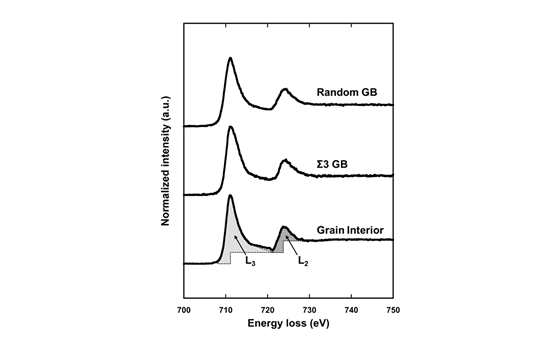Discovery of Increase in Magnetic Moment at Grain Boundaries
Clue to New Design Technique for Development of Future Magnetic Materials
2013.01.29
(2012.12.06 Update)
National Institute for Materials Science
Kumamoto University
The NIMS Structural Materials Unit, in joint research with a group at the Kumamoto University Graduate School of Science and Technology, experimentally measured the 3d electronic state of pure iron and discovered a phenomenon in which magnetic moment, which is one of physical properties expressing magnetic characteristics, increases at grain boundaries, and also clarified that the increase in magnetic moment depends on the grain boundary structure.
Abstract
- Dr. Seiichiro Ii, a Senior Researcher in the Structural Materials Unit (Unit Director: Kaneaki Tsuzaki) at the National Institute for Materials Science (President: Sukekatsu Ushioda), in joint research with a groups headed by Professor Sadahiro Tsurekawa of the Department of Materials Science and Engineering, Graduate School of Science and Technology (Dean of the Graduate School: Kazuki Takashima) of Kumamoto University, performed experimental measurements of the 3d electronic state of pure iron, and discovered a phenomenon in which magnetic moment, which is one of the important physical properties expressing magnetic characteristics, increases at grain boundaries. This research also clarified that the increase in magnetic moment depends on the structure of the grain boundary.
- Grain boundaries are 2-dimensional lattice defects that exist in polycrystalline materials, and are one important structural factor that determines the properties of polycrystalline materials. Each grain boundaries shows different not only physical but also chemical properties and those dependences are recognized as grain boundary character. Among the magnetic characteristics of materials, an effect of grain boundaries on the Barkhausen noise and the magnetic domain structure of magnetic materials had been confirmed experimentally. Magnetic moment is one key physical property that determines magnetic characteristics, and local increases in magnetic moment at grain boundaries had also been predicted by first-principles calculations. However, this phenomenon had not been clarified experimentally.
- Using pure iron, in which the grain boundary character had been determined in advance by electron backscatter diffraction (EBSD), the team headed by Dr. Ii measured the local magnetic moment of pure iron at the nano scale by transmission electron microscopy (TEM) and electron energy loss spectroscopy (EELS). The results of this research clarified the fact that the local magnetic moment at grain boundaries increases in comparison with the value inside grains.
- This research also revealed that these increases in local magnetic moment differs depending on the grain boundary character. Local magnetic moment increases as the relative misorientation of adjoining crystals increases, and reaches is maximum value when this misorientation is around 45°. As magnetic moment also decreased at grain boundaries with high coherency, this research showed that local magnetic moment displays grain boundary character dependence. This result would provide a new guideline for microstructural control techniques for improving the magnetic characteristics of magnetic materials, which are an important basic materials supporting advanced science and technology.
- These research results were obtained with the support of the Grants-in-Aid for Scientific Research (S) Program, “Innovation in Electromagnetic Science of Materials and Its Application to Practical Materials Processing” of Japan’s Ministry of Education, Culture, Sports, Science and Technology (MEXT). These results were published in the materials-related bulletin “Scripta Materialia” on December 3, 2012.

Figure: Electron energy loss spectroscopy (EELS) spectrum of Fe obtained from the interior of a pure Fe grain (bottom), the Σ3 grain boundary (middle), and a random grain boundary (top). The peaks in the figure are peaks that are called the L23-edges, respectively, from the high energy loss side. These two peaks are collectively called “white line”. Magnetic moment can be measured by obtaining the area of the white line surrounded by the dotted lines and profile and calculating its intensity ratio.
